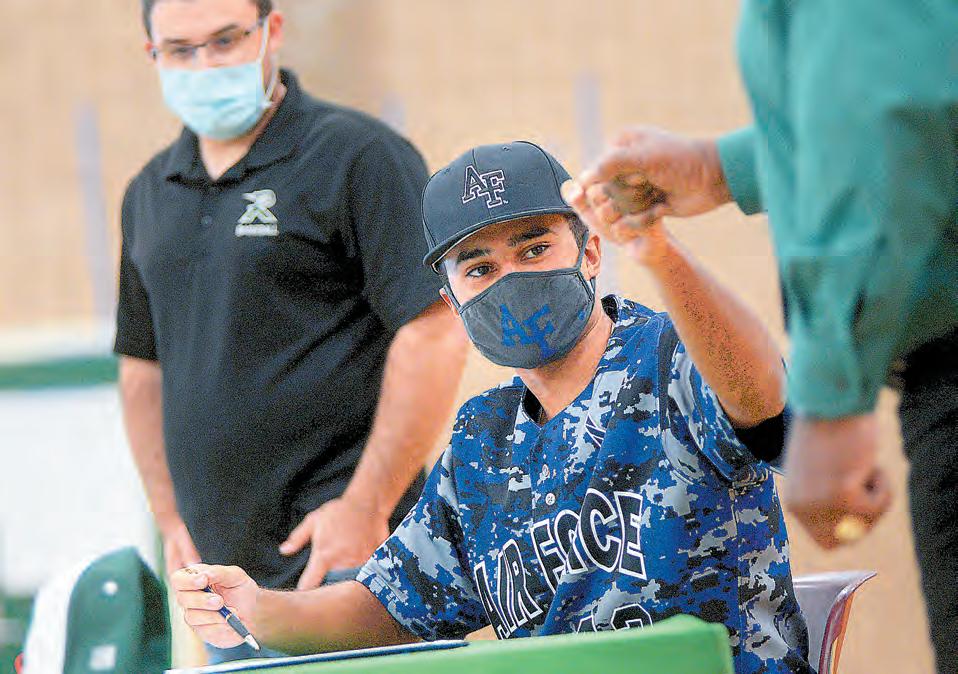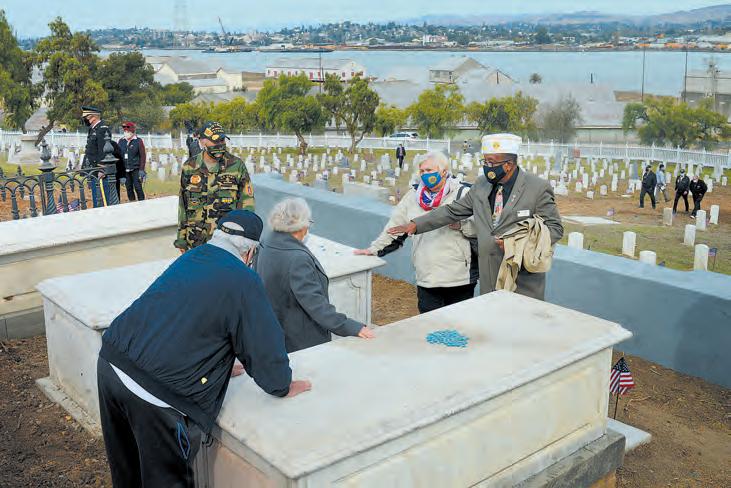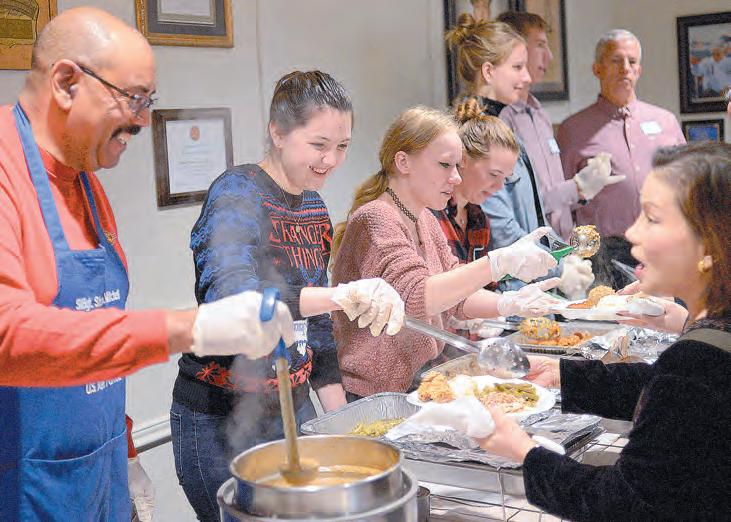Opinion
DAILY REPUBLIC — Friday, November 13, 2020 A5
this youth generation
The audacity of hate in US
I
’ve never witnessed such passionate displays of racial tension and hate in my entire lifetime. I was born in a year that many believe was one of the most racially contentious times in U.S. history: 1968. Being born and raised in Los Angeles, I’ve never witnessed any blatant acts of racism or hate crimes firsthand. I only heard of incidents in our history during the civil rights movement. I’d periodically hear of some violent hate crimes in certain areas of the country like the deep South: Louisiana, Mississippi, Georgia or Texas. Quite frankly, I never even heard many racial slurs directed toward me or any other person of color other than Deon D. Price the occasional “N” word from one black person to another as a twisted term of endearment. Racial hatred didn’t come into my consciousness until the early 1990s. I was in college when the Rodney King beating happened and the subsequent riots occurred in LA. Around the same time, the killing of Latasha Harlins happened at a neighborhood market in South Central LA. A surveillance video showed an immigrant Korean store owner shooting the teenager in the back of her head. The incident resulted in a community backlash that erupted over the appalling sentencing that was issued by Judge Joyce Karlin. Although the accused was found guilty of voluntary manslaughter, Karlin gave her a $500 fine, 400 hours of community service and five years of probation with no jail time. This helped spark and reignite a local movement against racial injustice against black and brown people in Southern California. Racial hate in America never really completely dissipated. It was just dormant, for lack of a better term. Systemic and institutional racism has been consistently present throughout this nation’s existence, from its very start. However, we are seeing a surge of more unapologetic racial hate among larger groups of people and in more geographic locations. Prior to this new movement of hate, you would hear of a few individuals performing a horrific hate crime here and there. James Byrd Jr., a Black man, was killed by three white supremacists in Jasper, Texas, on June 7, 1998. Byrd was dragged for 3 miles behind a pickup truck along an asphalt road in broad daylight. All three perpetrators of this horrific hate crime were eventually convicted and executed. Blatant acts of hate, bold bigotry and racism were sporadic and subtle 10 to 15 years ago. Those days are gone. Bold racism and hate have resurfaced with a new energy that many believe was cultivated and encouraged by political leaders that include the president. So-called Trump rallies have been compared by some to KKK rallies, even resulting in violent attacks on people with opposing views. A recent group of Trump supporters even took their opposition a step further and attempted to run a Biden campaign bus off the road in Texas. This goes beyond political differences and has crossed into violent hate crimes and domestic terrorism. Violent extremist groups have been popping up all over the country, targeting people of color but mainly Black people and even opposing political figures. The FBI foiled a plot in October by a militia group to abduct Michigan Gov. Gretchen Whitmer. News has surfaced in recent months of Black men being hung in public locations in various cities, including Los Angeles and most recently Sacramento. A colleague of mine facilitated a youth voting activity on Election Day by literally walking a group of first-time voters to a local voting location in San Francisco. The majority of the youth were Black or Hispanic. They were met with aggressive opposition. They were attacked with verbally abusive language and racial slurs that almost led to a physical altercation. Undoubtedly the political environment will grow even more contentious with the current president still refusing to concede to an obvious election defeat. It’s safe to say that the spirit and audacity of hate will continue to poison this nation if more love and respect for humanity does not prevail. “When the power of love overcomes the love of power the world will know peace.” – Jimi Hendrix Deon D. Price is an author and youth life skills coach who lives in Fairfield. He can be reached at thisyouthgeneration@gmail.com or www.deondprice.com.
DAILY REPUBLIC A McNaughton Newspaper Locally Owned and Operated Serving Solano County since 1855
Foy McNaughton
T. Burt McNaughton
President / CEO / Publisher
Co-Publisher
Glen Faison Managing Editor
This week’s question: Should there be a time limit to counting ballots? Go to www.daily republic.com/ pulsepoll to vote.
the bottom line
Democracy ends in Vacaville
T
he democratic process Agenda Item 9E, came up came to a screechat nearly four hours into the ing halt Tuesday at the meeting, which addressed City Council meeting how a council seat would be in Vacaville, as Mayor Ron replaced when vacated before Rowlett pushed through his the term expires. personal agenda against the Since Mashburn was cries of dozens of citizens elected to the county Board and two council members. of Supervisors in March, Rowlett placed two key his at-large council Danny Wells and agenda items near the end of a seat would be vacated after grueling five-and-a-half-hour the six voting districts meeting. The first, Agenda Item 9D, were created, Rowlett could have came up for discussion two hours and adopted a resolution to create equal57 minutes into the meeting, relating ity in representation of all districts, to how future agenda items would be and have Mashburn’s soon-to-be placed on the agenda. vacated and antiquated at-large Council members Nolan Sulcouncil seat replaced with a districtlivan and Dilenna Harris voiced based representative for District support for an item that could be 2. This could have been included placed on the agenda with the request in our Nov. 3 election, and elimiof a single or at least two council nate the cost of a special election or members. Sullivan noted at the prevacancy appointment. vious City Council meeting that in Rowlett instead passed a resoluthe two years he has been serving tion in May to set aside the special on the council he has yet to get one election process and has the mayor, single item on the agenda. Rowlett himself, appoint the vacated council made it clear he wanted a majority member’s replacement, essenvote from the council to let any item tially creating a situation where all reach his agenda. districts now have council represenOpinions from the public were tatives who reside in the district they heard with every voice requesting represent except those citizens who that a request from only one or two live in District 2. council members should be required Again, council members Sullito get an item on the agenda to uphold van and Harris voiced strong opinion the democratic process. Against that the replacement for Mashthe will of the public voices and two burn’s seat should come from District of his council members, Rowlett 2 and that the decision on how it ensured his majority-rule posiwould be filled should be left to the tion remained intact when the usual newly elected council that will take 3-2 vote ended. office in January. I say usual, because after sitting Although in the previous council in on dozens of City Council meetings meeting Rowlett deferred the continthe pattern is clear. Rowlett decides uation of the citizen’s OPEB advisory what he wants and Mitch Mashburn committee to next year’s council, he and Raymond Beatty follow his lead. reversed his position on this issue. While council members Sullivan and An avalanche of citizens, mostly Harris study the issues, come to the living in District 2, called to voice meetings prepared to comment and their support for a council member propose much-needed solutions to our replacement being a resident of their city’s severest problems, I have yet district and to let the new council in to hear Beatty (who was appointed January make this decision. by the mayor, not elected) do or say Against the wishes of two eloquent anything at a council meeting except council members, and 532 citizens “aye” when Rowlett calls for a vote on from District 2 who petitioned for an issue he wants passed. the right to choose their own repreThe hot issue of the evening, sentative, Rowlett decided a special
election for an at-large member would be best for the city. The cost of a special election is $580,000. Yes, your mayor just pushed through an edict to spend more than a half-million dollars on a special election next year, for a representative the citizens could have voted on in November without any additional cost. District 2 has only 10,881 registered voters, and a District 2-only special election would be 80% less expensive than an at-large council seat election of all 58,000 registered voters in Vacaville. Although Mashburn’s notice of vacancy was delivered Nov. 4, his actual vacancy as stated in his letter does not occur until Dec. 31, so there is no rush to push this through now. A host of citizens called in passionately asking Rowlett to let the new council decide, yet with a single brush he labeled all of those citizens “the vocal minority.” Then, peppering his dialogue with “transparency,” motioned to make the call himself for a special election. The democratic process ended in Vacaville that evening. This year’s OPEB advisory committee made several recommendations to reduce Vacaville’s enormous unfunded liability, which has our city ranked in the bottom 10% of all California cities in terms of financial health. None of the committee’s recommendations for financial improvement were acted upon by the mayor. But please, don’t take my word for this. Visit the city’s website and listen to the Nov. 10 City Council meeting yourself. You can fast forward to these crucial issues and brace yourself for what you will hear. Our prayers are with the newly elected council members who take office in January and who will hopefully reclaim and truly represent the voice of the people – something the mayor has long since abandoned. Danny Wells is a citizen of Vacaville and can be reached at danny@ dannywells.com.
calmatters commentary
Orange County shows conservative streak
R
onald Reagan chose population – in part due to Mile Square Park, in the collapse of the aerospace the heart of Orange industry – and an increase in County, for a Labor Asian and Latino residents. It Day rally in 1984 to kick also had become less rigid in off his final push for a its attitudes on social issues, second term as president. such as abortion and sameAs large as the park is – a sex marriages. square mile – it was jammed With Donald Trump with thousands of flag-waving, seeking another term, this Dan Walters cheering Reagan supporters, year’s election appeared to be attesting to Orange County’s status another opportunity for Democrats as a bastion of California Republican to expand their Orange County prespolitical strength. ence, and in a sense they did. Orange Although Democrats had had County again voted Democratic for some momentary success in the president and two Republican state county a decade earlier, by 1984 virsenators, John Moorlach and Ling tually every local congressional, Ling Chang, were ousted by Demolegislative and local government cratic challengers. office was held by a Republican. It However, two Democrats who was the barb on what political junkies had won previously Republican concalled the “fishhook” of GOP-voting gressional seats in 2016, Gil Cisneros counties that dominated statewide and Harley Rouda, lost them after politics at the time. serving just one term. And in other Even as Republican power waned ways, this year’s election indicated in the state after the turn of the that Orange County is still, relacentury, Orange County retained a tive to other coastal counties, fairly fairly strong GOP tilt – until Donald conservative. Trump came along. Joe Biden walloped Trump by a In 2016, for the first time in nearly 2-to-1 landslide in California, 80 years, Orange County’s voters but in Orange County, based on the opted for a Democratic presidenunofficial returns, Biden’s margin tial candidate, Hillary Clinton, and was much narrower, just 10 pertwo years later showed their disdain centage points. for Trump again by ousting several Candidate contests at any level Republican congressional members. are only partial tests of ideological There was, however, more to the bent because personalities – such as county’s political evolution than Trump’s bombastic ways – enter into just dislike of Trump. Like the rest the equation. A better gauge is the of California, Orange County had vote on ballot measures in which perundergone a demographic change, sonalities play little or no role. particularly a decline in its white With their votes on the most ideo-
logically distinct ballot measures this year, the innate political conservatism of Orange County voters was still evident. Proposition 15, a labor unionbacked measure to increase property taxes on commercial real estate such as hotels and office buildings, failed by a few percentage points statewide, but in Orange County it lost by a 3-to-2 margin. Proposition 16, which would have restored affirmative action in public college admissions, hiring and contracting, failed with just over 40% of the statewide vote but in Orange County, support was nearly 10 percentage points smaller. Proposition 22, a measure backed by Uber, Lyft and other app-based transportation services to exempt their contract drivers from a new state law that would have made them employees, won by a 3-to-2 margin statewide, but the “yes” vote was 8 percentage points higher in Orange County. Clearly, Orange County is no longer the impregnable Republican fortress it was in 1984, but neither is it as blue as Democrats have hoped. One could say that it’s purple with a stubborn streak of conservatism that sets it apart from the rest of coastal California. CALmatters is a public interest journalism venture committed to explaining how California’s state Capitol works and why it matters. For more columns by Dan Walters, go to calmatters.org/commentary.







